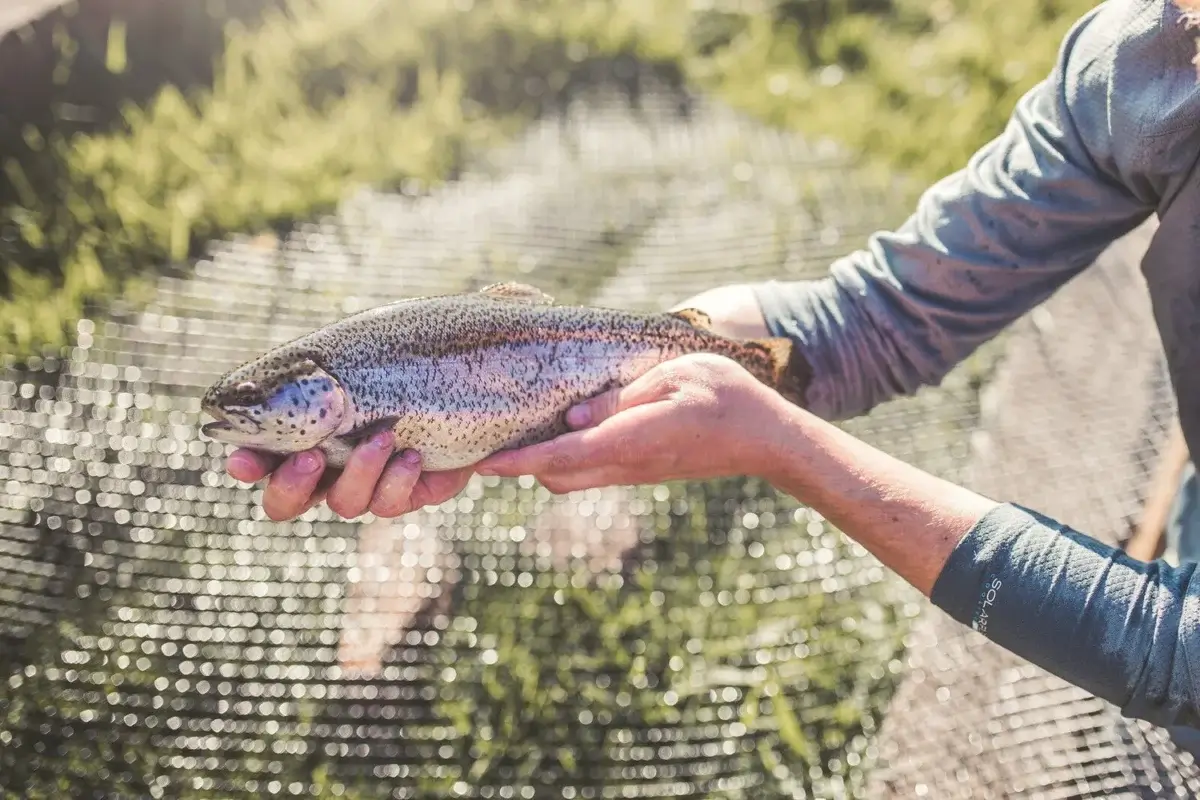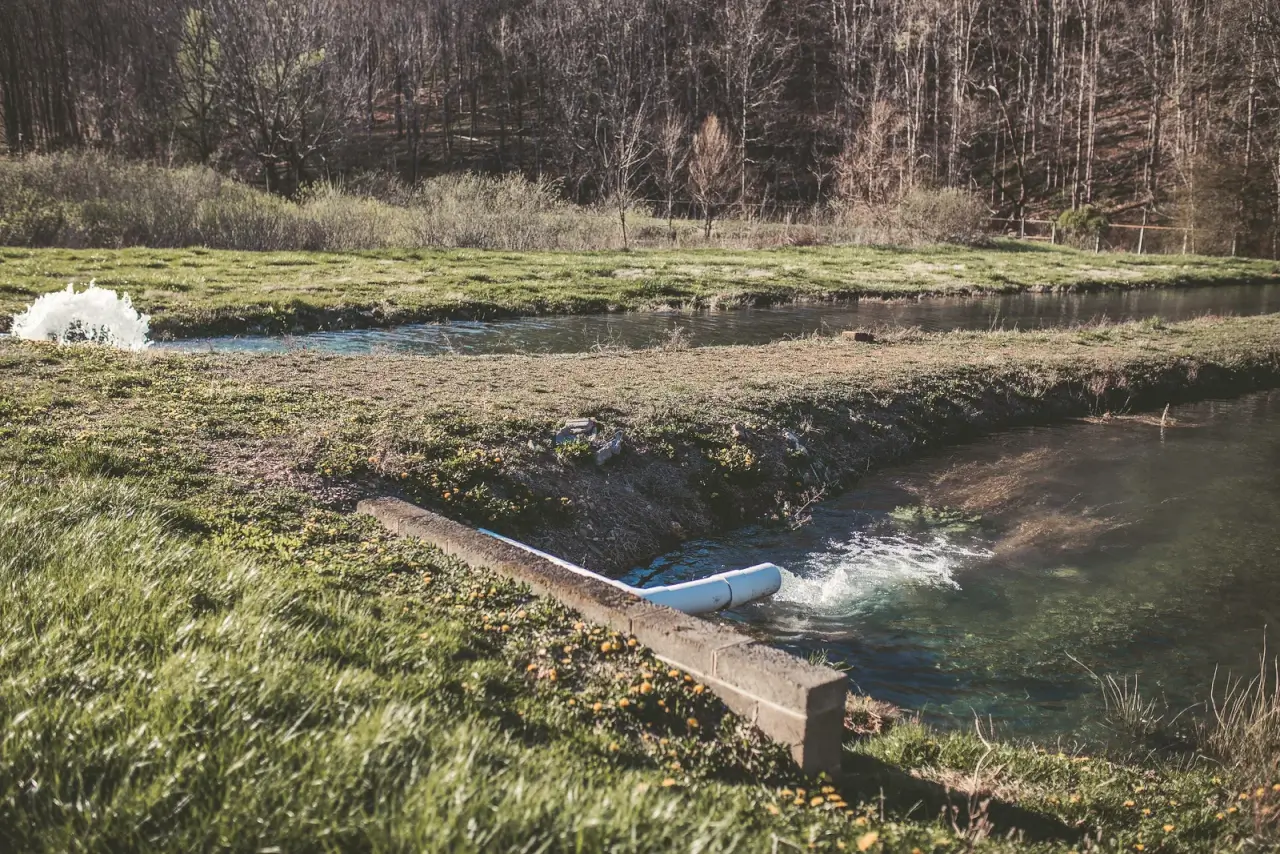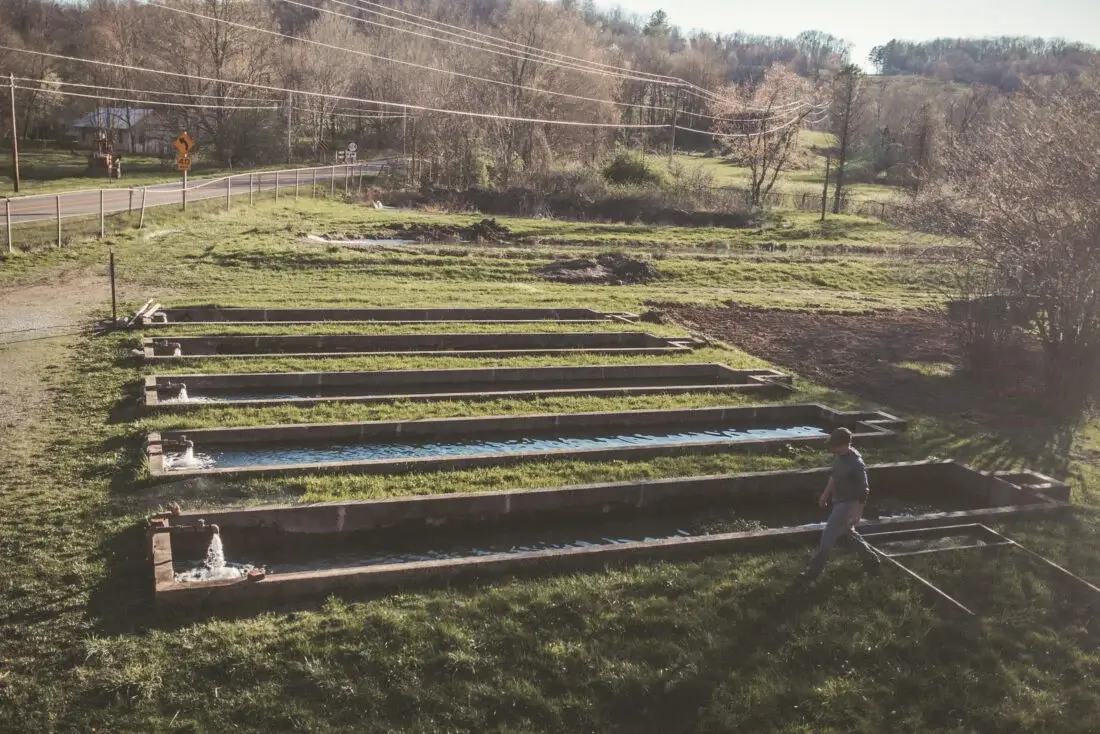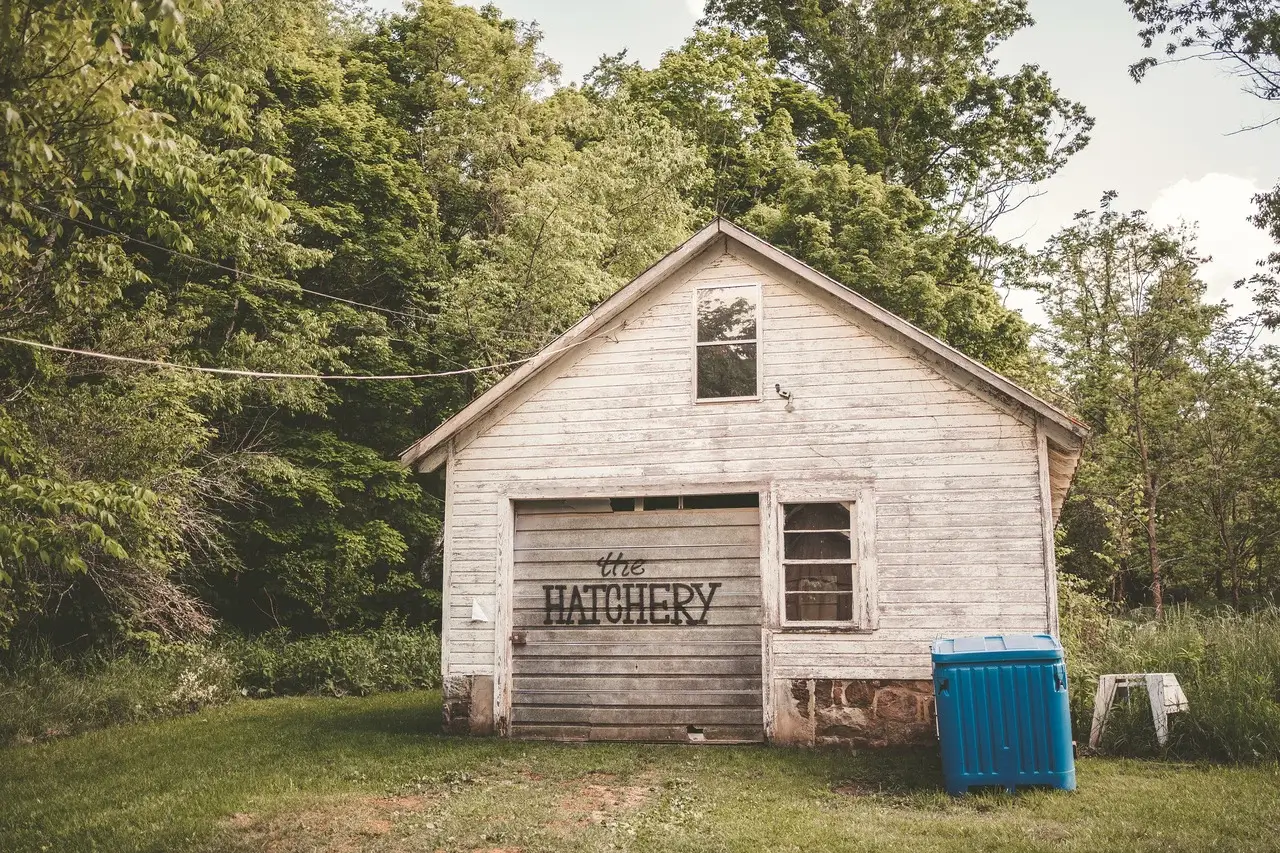Meet the Modern Trout Farmer Using Gravity to His Advantage
Ty Walker wants to bring old-school, sustainable trout farming back to Virginia—and he’s succeeding.
Meet the Modern Trout Farmer Using Gravity to His Advantage
Ty Walker wants to bring old-school, sustainable trout farming back to Virginia—and he’s succeeding.

Photography courtesy of Smoke in Chimneys.
Ty Walker stands thigh-deep in clear, swift-flowing spring water, tearing fistfuls of overgrown watercress and aquatic grass from the mouth of a 150-foot-long, 10-foot-wide earthen pond. Hundreds of mature, iridescent rainbow trout dart across the pebbly bottom as he clears vegetation from a creek-like channel leading to a big iron pipe that spews water into the pond.
“Trout need lots of clean, fresh oxygen to thrive,” says Walker, 34. Some grass is good, but too much can deplete dissolved oxygen, slow waterflow and clog drains, “which stresses the fish. And calm fish are healthy fish; healthy fish are delicious fish.”

This is part of Walker’s annual maintenance routine at Smoke In Chimneys trout farm, which opened in 2019. He’ll spend the day weeding and cleaning, then harvest the remaining fish in the next week or so. The pond then gets a break from production to naturally incorporate or filter out excess nutrients from the ecosystem. In the fall, it will again be loaded with thousands of baby trout. They’ll start their lives here, then cycle through a dozen similar impoundments—that together hold more than 20,000 fish at various stages of maturation—for about two years until they’re ready for harvest.
“It takes a stupid amount of labor to do it this way compared to big commercial aquaculture operations,” says Walker. “But this is the only way to raise trout that consistently taste like they’ve been pulled fresh out a mountain stream.”
That’s because the pond is part of a restored, 1930s US Department of the Interior gravity-fed trout hatchery and research facility in Virginia’s Blue Ridge Mountains that was abandoned in the early 1990s due to budget cuts and remoteness. Here, there are no electric pumps, plastic tanks, antibiotics, mechanical agitators, recirculated water, chemical additives, or computer monitoring. Water comes from a pristine, 54-degree spring that gushes from the bedrock at 2,000 gallons a minute. It is carried to the ponds through a series of pipes and concrete raceways that mimic natural trout streams, then empties into an adjacent creek. The shale-bottom impoundments are lined with native plants, surrounded by pollinator gardens and selectively managed forest. They’re filled with naturally occurring microbes, insects, amphibians, and crustaceans. Walker and two employees hand-survey populations monthly for signs of illness or stress. They harvest and process about 400 whole trout a week, then pack them in coolers for shipping to restaurants and individual customers.
learn more
Can interactive mapping tools help shellfish restoration?
“There are a lot of small-scale trout producers in the US, but this is truly a diamond-in-the-rough situation,” says freshwater aquaculture researcher and current US Trout Farmers Association president Jesse Trushenski. Most similar facilities either vanished during the big-ag-fueled Blue Revolution of the 1950s, ‘60s, and ‘70s or are still used to supplement native wild trout populations for fishing. Then there’s the production side: The nation’s largest commercial producer—Boise, Idaho-based Riverence—churns out more than 22 million pounds of trout a year compared to Smoke In Chimney’s give-or-take 120,000.
This is a small, extremely high-end facility operating on historic infrastructure, says Trushenski. “If other commercial facilities [like the Walker’s] exist, there can’t be more than one or two.”
Walker also touts Smoke In Chimney’s sustainability versus typical fish-focused commercial aquaculture farms. On one hand, he likens his farm’s production methods to the inland freshwater equivalency of regenerative livestock farming.
“This approach is without a doubt going to affect a net positive environmental impact,” says Trushenski. The system acts like a natural waterway, using gravity and hydrostatic pressure to move perfectly balanced water from a limestone aquifer. It requires no electricity or additives to operate. It’s effectively a restored habitat for depleted natural fish populations where, like rotational grazing, trout cycle through different impoundments as they grow and mature, nurturing their needs while playing a supportive role in the overall ecosystem. A percentage of newly hatched fish escapes into the nearby stream, bolstering habitat and wild populations.

Meanwhile, more farm-raised trout on the market means less extractionary pressure on local streams. It also helps balance the increasing gap in wild-caught seafood production due to overfishing, climate change, and human population growth.
“This is an ecological win-win,” says Trushenski. “You’re boosting stream health and native fish populations while making inroads on a problem that is only going to get worse with time.”
Walker appreciates sustainability and historic novelty—and leverages both to market and tell the story of his trout—but he’s more concerned with the quality of product the method yields. And testimonies back up his claims.
“There’s this rich, nutty, buttery decadence. It tastes clean and refreshing, like spring water,” says Patrick Pervola, research and development chef at Michelin-starred Washington D.C. eatery, Albi. “This is some of the best fish I’ve tasted in my career. It rewrites what you think of as possible for farm-raised fish.”

But despite all the benefits—and roughly 2,900 miles of native wild trout streams—Smoke In Chimneys is one of about three other commercial trout farms in Virginia. And the others are tiny by comparison and sell almost exclusively to family friends or at local farmer’s markets. That means, by Trushenski’s estimate, about 95 percent of trout consumed in Virginia comes from production strongholds like Idaho, Washington, or North Carolina.
She says the problem stems from issues around education.
learn more
Find out which fish is sustainably farmed with help from Seafood Watch.
First, most seafood consumers have never tasted wild-caught or truly healthy farm-raised trout, and that lack of exposure leads to decreased demand. Second, Virginia focuses aquatic agricultural resources on marine seafood, so there are no dedicated high school or collegiate-level educational programs for inland freshwater aquaculture. And would-be farmers can’t pursue opportunities they don’t know about.
“To put it into perspective: When I started out, I called around to agricultural extension offices at [the state’s leading universities] and there was literally nobody there that could tell me anything useful about farm-raised trout,” says Walker. “I had to rely on old books from the 1930s I dug up on eBay, rangers working at hatcheries, farmers in other states, and trial-and-error to figure it out.”

But Walker remains undaunted. He and wife, Shannon, spent a year sifting through regulatory red tape and launched a small USDA-inspected processing plant near the farm. They work tirelessly on social media and with restaurateurs to educate eaters about the virtues of healthy, farm-raised trout.
read more
Tinned fish is trending. Can you trust the label?
Walker has also joined the Virginia Department of Agriculture and Consumer Services Aquaculture Advisory Board and is in talks with administrators at the new Virginia Tech Aquaculture and Seafood Production Facility. He’s using the position and access to advocate for increased resources around gravity-fed inland freshwater aquaculture. He envisions a future where Smoke In Chimneys has expanded to include one to two dozen sister farms and helped dramatically increase trout consumption throughout the state and Mid-Atlantic.
We have “the natural resources and the market potential is there,” says Walker, noting $67.5 million in USDA-reported 2018 sales at farms in the top two US trout-producing states alone. “All we need is the support to help us get the ball rolling and tap into that potential. And I don’t plan to quit until that happens. I want to remind Virginians why trout is our state fish.”
Follow us
This work is licensed under a Creative Commons Attribution-NoDerivatives 4.0 International License.
Want to republish a Modern Farmer story?
We are happy for Modern Farmer stories to be shared, and encourage you to republish our articles for your audience. When doing so, we ask that you follow these guidelines:
Please credit us and our writers
For the author byline, please use “Author Name, Modern Farmer.” At the top of our stories, if on the web, please include this text and link: “This story was originally published by Modern Farmer.”
Please make sure to include a link back to either our home page or the article URL.
At the bottom of the story, please include the following text:
“Modern Farmer is a nonprofit initiative dedicated to raising awareness and catalyzing action at the intersection of food, agriculture, and society. Read more at <link>Modern Farmer</link>.”
Use our widget
We’d like to be able to track our stories, so we ask that if you republish our content, you do so using our widget (located on the left hand side of the article). The HTML code has a built-in tracker that tells us the data and domain where the story was published, as well as view counts.
Check the image requirements
It’s your responsibility to confirm you're licensed to republish images in our articles. Some images, such as those from commercial providers, don't allow their images to be republished without permission or payment. Copyright terms are generally listed in the image caption and attribution. You are welcome to omit our images or substitute with your own. Charts and interactive graphics follow the same rules.
Don’t change too much. Or, ask us first.
Articles must be republished in their entirety. It’s okay to change references to time (“today” to “yesterday”) or location (“Iowa City, IA” to “here”). But please keep everything else the same.
If you feel strongly that a more material edit needs to be made, get in touch with us at [email protected]. We’re happy to discuss it with the original author, but we must have prior approval for changes before publication.
Special cases
Extracts. You may run the first few lines or paragraphs of the article and then say: “Read the full article at Modern Farmer” with a link back to the original article.
Quotes. You may quote authors provided you include a link back to the article URL.
Translations. These require writer approval. To inquire about translation of a Modern Farmer article, contact us at [email protected]
Signed consent / copyright release forms. These are not required, provided you are following these guidelines.
Print. Articles can be republished in print under these same rules, with the exception that you do not need to include the links.
Tag us
When sharing the story on social media, please tag us using the following: - Twitter (@ModFarm) - Facebook (@ModernFarmerMedia) - Instagram (@modfarm)
Use our content respectfully
Modern Farmer is a nonprofit and as such we share our content for free and in good faith in order to reach new audiences. Respectfully,
No selling ads against our stories. It’s okay to put our stories on pages with ads.
Don’t republish our material wholesale, or automatically; you need to select stories to be republished individually.
You have no rights to sell, license, syndicate, or otherwise represent yourself as the authorized owner of our material to any third parties. This means that you cannot actively publish or submit our work for syndication to third party platforms or apps like Apple News or Google News. We understand that publishers cannot fully control when certain third parties automatically summarize or crawl content from publishers’ own sites.
Keep in touch
We want to hear from you if you love Modern Farmer content, have a collaboration idea, or anything else to share. As a nonprofit outlet, we work in service of our community and are always open to comments, feedback, and ideas. Contact us at [email protected].by Eric J. Wallace, Modern Farmer
July 8, 2024
Modern Farmer Weekly
Solutions Hub
Innovations, ideas and inspiration. Actionable solutions for a resilient food system.
ExploreExplore other topics
Share With Us
We want to hear from Modern Farmer readers who have thoughtful commentary, actionable solutions, or helpful ideas to share.
SubmitNecessary cookies are absolutely essential for the website to function properly. This category only includes cookies that ensures basic functionalities and security features of the website. These cookies do not store any personal information.
Any cookies that may not be particularly necessary for the website to function and are used specifically to collect user personal data via analytics, ads, other embedded contents are termed as non-necessary cookies.
The post presented me with a wealth of information, allowing me to broaden my horizons
Loved reading your article. it was really informational for me. wish to see more in the coming days.